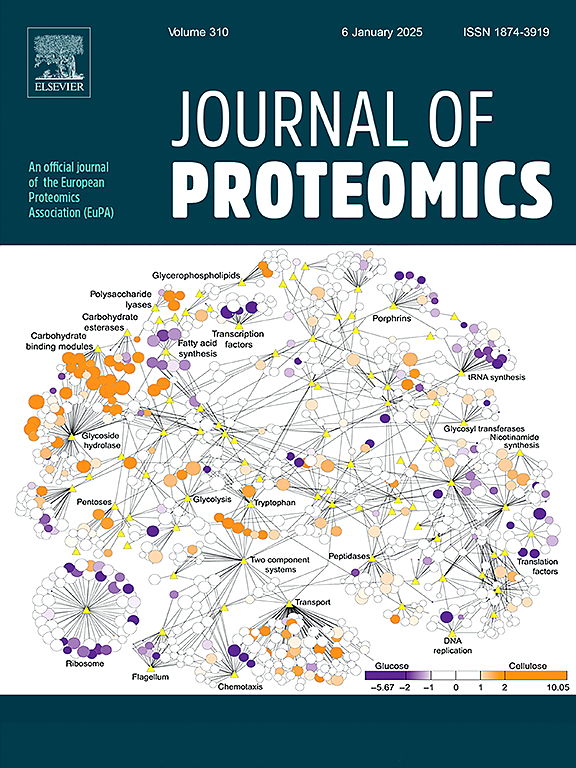番茄细菌性斑疹病新的潜在易感因子。
IF 2.8
2区 生物学
Q2 BIOCHEMICAL RESEARCH METHODS
引用次数: 0
摘要
本研究采用无标记霰弹枪蛋白质组学分析,旨在了解番茄对黄单胞菌(Xanthomonas euvesicatoria pv)易感性的分子机制。perforans (Xep)。为了实现这一点,在接种(hai)后24和48 h,用细菌和对照组(盐水溶液)对易感植株进行了比较蛋白质组学研究。结果显示,大多数鉴定的蛋白质在感染组中丰度增加,并被划分为不同的基因本体组。其中8个蛋白与其他病理系统的易感性相关,表明它们可能参与番茄细菌性斑疹病的发生。其中一些蛋白质参与水杨酸、PR蛋白和活性氧(ROS)的负调控,并有助于病原体获取糖。本研究结果为了解番茄对Xep易感的分子机制提供了有价值的信息,对培育番茄抗菌斑品种具有指导意义。意义:我们对受Xep侵染的番茄植株进行蛋白质组学研究,从而鉴定出可能导致番茄细菌性斑点病发展的蛋白质。这些蛋白质可以以不同的方式对病原体有利,例如对参与植物防御的植物激素进行负调节,抑制PR蛋白和活性氧,以及协同获取糖供病原体营养。本文章由计算机程序翻译,如有差异,请以英文原文为准。

New potential susceptibility factors contributing to tomato bacterial spot disease
The label-free shotgun proteomics analysis carried out in this study aimed to understand the molecular mechanisms that contribute towards tomato susceptibility to Xanthomonas euvesicatoria pv. perforans (Xep). To achieve this, comparative proteomics was performed on susceptible inoculated plants with the bacterium and the control group (saline solution) at 24 and 48 h after inoculation (hai). The results revealed that most of the identified proteins showed increased abundance in the infected group and were classified into different gene ontology groups. Eight of these proteins were related to susceptibility in other pathosystems, suggesting their potential involvement in the development of bacterial spot in tomato. Some of these proteins are involved in the negative regulation of salicylic acid, PR proteins and reactive oxygen species (ROS), as well as contributing to the acquisition of sugars by the pathogen. The results obtained in this study provided us with valuable information for understanding the molecular mechanisms that lead to tomato susceptibility to Xep and will help in developing tomato cultivars resistant to bacterial spot.
Significance
Our proteomic study of tomato plants during infection by Xep allowed for the identification of potential proteins that contribute to bacterial spot tomato disease development. These proteins can act in different ways to favor the pathogen, such as the negative modulation of phytohormones involved in plant defense, the inhibition of PR proteins and reactive oxygen species, as well as to collaborate in the acquisition of sugar for pathogen nutrition.
求助全文
通过发布文献求助,成功后即可免费获取论文全文。
去求助
来源期刊

Journal of proteomics
生物-生化研究方法
CiteScore
7.10
自引率
3.00%
发文量
227
审稿时长
73 days
期刊介绍:
Journal of Proteomics is aimed at protein scientists and analytical chemists in the field of proteomics, biomarker discovery, protein analytics, plant proteomics, microbial and animal proteomics, human studies, tissue imaging by mass spectrometry, non-conventional and non-model organism proteomics, and protein bioinformatics. The journal welcomes papers in new and upcoming areas such as metabolomics, genomics, systems biology, toxicogenomics, pharmacoproteomics.
Journal of Proteomics unifies both fundamental scientists and clinicians, and includes translational research. Suggestions for reviews, webinars and thematic issues are welcome.
 求助内容:
求助内容: 应助结果提醒方式:
应助结果提醒方式:


